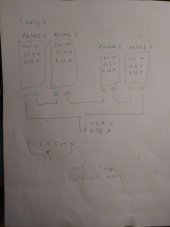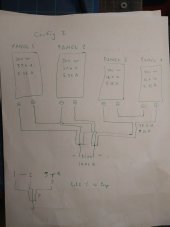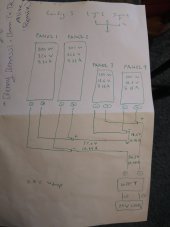I've been going through some different panel configurations for my vanbuild. See the attached drawings of configs 1, 2, & 3.
Config 1 - All four panels in series. Produces 112 V, 5.32 A into the charge controller. 0.12% voltage drop.
Config 2 - Panels 3 & 4 in series, then 1 + 2 + 3/4 in parallel. Produces 37.2 V, 16 A into the charge controller. 1.12% voltage drop.
Config 3 - Panels 1&2 in parallel, panels 3&4 in parallel, then 1/2 + 3/4 in series. Produces 56.2 V, 10.6 A into the charge controller. 0.5% voltage drop.
This is a system I've already built, but am upgrading/redesigning. I'm getting a new charge controller (current one is undersized), and already have 10AWG wire in place (voltage drop calculations made using 10AWG wire). I already own panels 1 and 2, and am looking at purchasing 3 and 4 (all Richsolar panels). The charge controller feeds a LiFePO4 24V bank.
My thoughts on the configs:
Config 1 Seems like the worst to me. A monster 112 V into the charge controller is going to be inefficient. The only advantage is a low voltage drop.
Config 2 seems okay, but the highest current of the three configs produces the highest voltage drop of the three at 1.12%. This isn't a deal breaker, but I still would like to be as efficient as possible.
Config 3 seems like the best choice to me. 56 V wouldn't be too high for a controller, and 0.5% voltage drop is just fine. I've never seen someone make a setup like this where it's parallel first and then series; as far as hybrid configurations, I've only ever seen panels in series, and then parallel.
Will Config 3 work and is it my best bet here? Anyone have a charge controller to recommend? I have the Epever Tracer 1215BN, but it caps out at 10A max output.
Config 1 - All four panels in series. Produces 112 V, 5.32 A into the charge controller. 0.12% voltage drop.
Config 2 - Panels 3 & 4 in series, then 1 + 2 + 3/4 in parallel. Produces 37.2 V, 16 A into the charge controller. 1.12% voltage drop.
Config 3 - Panels 1&2 in parallel, panels 3&4 in parallel, then 1/2 + 3/4 in series. Produces 56.2 V, 10.6 A into the charge controller. 0.5% voltage drop.
This is a system I've already built, but am upgrading/redesigning. I'm getting a new charge controller (current one is undersized), and already have 10AWG wire in place (voltage drop calculations made using 10AWG wire). I already own panels 1 and 2, and am looking at purchasing 3 and 4 (all Richsolar panels). The charge controller feeds a LiFePO4 24V bank.
My thoughts on the configs:
Config 1 Seems like the worst to me. A monster 112 V into the charge controller is going to be inefficient. The only advantage is a low voltage drop.
Config 2 seems okay, but the highest current of the three configs produces the highest voltage drop of the three at 1.12%. This isn't a deal breaker, but I still would like to be as efficient as possible.
Config 3 seems like the best choice to me. 56 V wouldn't be too high for a controller, and 0.5% voltage drop is just fine. I've never seen someone make a setup like this where it's parallel first and then series; as far as hybrid configurations, I've only ever seen panels in series, and then parallel.
Will Config 3 work and is it my best bet here? Anyone have a charge controller to recommend? I have the Epever Tracer 1215BN, but it caps out at 10A max output.





